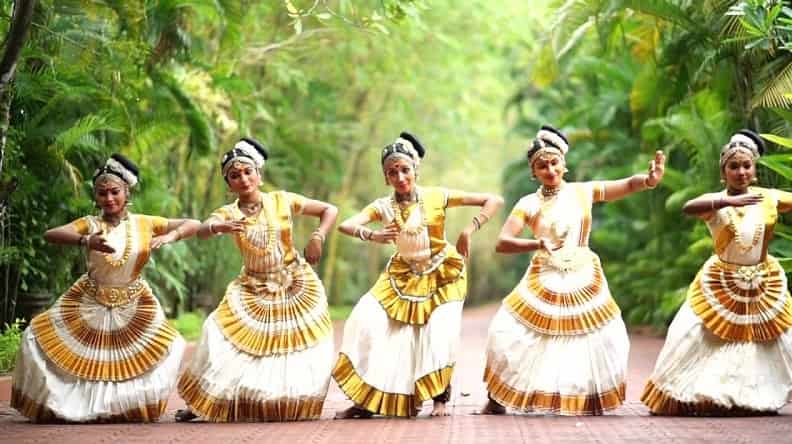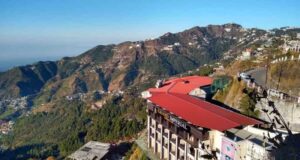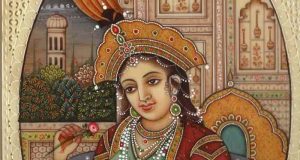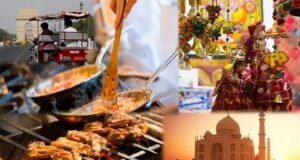Most Famous Traditional Art and Dance Forms of Kerala
Dance is entertaining art forms connected to spirit of Kerala’s Cultural Revolution. ‘God’s Own Country’. Kerala has one of the most celebrated ethnicity in dancing and performing arts of artistic activity. The first is the highly sophisticated stylized folk dances; the second type is the ‘Bharatanatyam’ which came from-the neighboring areas of the former Tamil Nadu and the third is the modern Kathakali which is a combination of the folk and classical traditions in dancing.
These elements came to be blended in such a manner that a highly advanced and unique type of dance drama came to be evolved.
Traditional Dances in Kerala
The term ‘Dance’ means the rhythmic movement of the body in agreement with the music and tala. It is a visual art or a drisyakala. It might have originated from the means of communication used by the man during the very early periods-even from the pre-paleolithic age.

The development in dancing is closely linked to the development of society itself. Dancing in the ancient days of our culture was practiced mostly in Temples as a part of festivals and ceremonies. The temple architecture was also influenced by the styles of dancing.
Kerala has one of the most glorious traditions in dancing and performing arts of artistic activity. The first is the highly sophisticated stylized folk dances; the second type is the ‘ Bharatanatyam ‘ which came from-the neighboring areas of the former Tamil Nadu and the third is the modern Kathakali which is a combination of the folk and classical traditions in dancing.
On many of the local festivals of temples are celebrated with the help of different kinds of dances. Usually most of the traditional dances of Kerala are performed by folk songs and with drums (which are the commonest musical instruments) often praising the deities. These folk dances of Kerala are considered to be the precursors of the later Kathakali.
New techniques of expression came to be developed in Kerala dance with the advent of these classical dance forms of Kerala. Classical emotions (rasa) were expressed with the hands (Mudra, Angya) reinforced by highly developed and classical facial expression were evolved in these dance forms of Kerala. But these elements came to be blended in such a manner that a highly advanced and unique type of dance-drama came to be evolved.
Kerala Folk Dances
There are wide many folk dances of Kerala each peculiar to the locality, community and situation. The costumes also vary accordingly. There are more than fifty Kerala folk dances acknowledged by the public relation department of the state, of which Kaikottikali, Kolkali, Oppana, Margamkali, Thumbithullal, Velakali, Parichamuttukali and Therayattam are among the more common.

Indian Folk Dances Of Kerala Therayattam or Theyyam-thera is a scared dance performed especially in the villages of Northern Kerala. In every villages there is usually a Kavu (sacred grove), where this dance has to be performed during the January –March season. The main deity may be a local goddess or one from the main Hindu pantheon. The dancers, in elaborate costumes and make up impersonate all some of the minor gods. The performance commences with a song narrating the history of the Theyyam to be presented, highlighting its holy aspects and the ferocious nature. At the end of the song, the performer appears with a theyyam (literally the embodied god) and dances to the accompaniment of percussion instruments, like the chenda and elathalam. It is a surrealistic transcendence from frail human to powerful deity.
Kaikottikali
[
Kaikottikali Folk Dance Steps Kerala Kaikottikali also known as Tiruvathirakali, because of its association with Thiruvathira, a Kerala festival meant mainly for Nayar women, features performers wearing the mandu (loincloth) and neriyatu (a elongated upper garment with the golden zari fringes), with their hair worn in a jasmine adorned bun and pushed slightly to the right. The women first form a circle around an oil lamp. This Kerala folk dance starts with a song called Thiruvathira pattu, as they move clockwise clapping their hands in unison. When the dance gains momentum, the movement at times becomes anti-clockwise and the clapping more vigorous.
Kolkali

Kolkali is performed by Hindu as well as Muslim communities; Kolkali dance is the tandava version of Kaikottikali. Here the performers are the men. Instead of clapping hands, they clash.
Oppana

Kerala Oppana is a Muslim folk dance of Kerala performed by the women folk, prior to the nikah (marriage) ceremony. The dancers wear the typical Muslim dress with mundu, the kuppayam (full sleeved blouse) and the that tom (the veil pulled over the hair). The performers form the circle around the bride who is dressed in her best. The dance starts with the oppana pattu (song). While dancing, they gracefully move inwards and outwards with every step.
Thumbi Thullal

Thumbithullal is performed during the Onam season as part of the celebrations. Girls in their early teens, each dressed in onakkodi (new dress meant for celebrating the onam) sit around in a circle round the key performer. They then sing in chorus to the accomplishment of clapping and occasional korava (an ululating sound). As the song gains momentum, the central girl goes into the trance and begins dancing faster and faster unless she eventually loses consciousness.
Velakali

Velakali is a marital dance form to commemorate the victory of god over evil. This Kerala dance is performed nowadays during the procession of the deity at temple festivals. The performer, armed with fake swords and sham shields, dance with vigour in front of the deity. The traditional panchavadya provide the accompaniment.
Parichamuttukali

Parichamuttukali is a marital dance form of the Travancore Christians and is believed to have evolved while Kalaripayattu was at its peak in Kerala. The performer, dressed like warriors and with fake sword and shields in their hands move in a circle. This Kerala Dance is like a mock fight. A song about Thomas the Apostle is sung during the performance.
Kerala Classical Dances
The classical dance forms of Kerala are characterized by their deliberate attempt at artistry. These dances of Kerala are mainly structured on the principles stated by the scriptures and technical texts on dance. Some (Koodiyattam, Kathakali etc.) are dance drama; others (e.g. Thullal, Mohiniyattam) are solo dances. The signs and gestures of the dance are based on Natya Shastra of Bharata.
Koodiyattam

Kerala Traditional Dance Koodiyattam literally means dancing together. The predominant element is abhinaya (acting). This has been probably the original form of Sanskrit drama and is strictly according to the tenets of Bharata. Koodiyattam is believed to be the oldest dance drama in existence in India. The accompanying musical instruments are different types of drums, the conch and different types of pipes.
The female roles are enacted by women belonging to Chakkiyar-Nambiar caste (called Nangiyar). The make-up of the performer is elaborate and a drama may extend through several nights. The mizhavu, a huge earthen or copper drum with a skin covering its single face, is played by Chakkiyar-Nambiar and the cymbal accompaniment by a variyar.
Thullal

Kerala Classical Music Thullal is one of the solo dances of Kerala. The poet Kunchan Nambiar is considered the father of this art form. The wit and humor in the simple Malayalam songs make this art the most popular dance form of Kerala. Dance is the predominant element of the performance. It includes rhythmic movements of the body with occasional vigorous footsteps. Based on the costumes and the dance forms Thullal is divided into Ottan, Seethankan and Parayan.
In Ottan Thullal the costume is impressive. A red festoon of cloth made up into knee length skirt and a crown and a chest plate of various colored beads, glass and tinsel are essential parts of the costume. The face is always painted and the eyes are darkened with black eye liner. The songs are of various tempos and the dance is vigorous.
In Seethankan Thullal, the ornaments are made up of fresh tender coconut fronds. The face has no coloration except for the blackening of the eyelids. The songs and the footsteps are slower than in the Ottan Thullal.
In Parayan Thullal, the costumes are made up of red flowers. The face is painted yellow and the head is covered with a black cloth. In performance the dance element is almost nonexistent; instead the performer explains the words through gestures. The main feature of this dance form of Kerala is the lyrics, which incorporates acute social criticism. Maddalam (drum) and chelanka (anklets worn by the dancer) are the accompanying instruments in Thullal.
Mohiniyattam

Classical Dance Kerala Mohiniyattam is a seductive dance form of Kerala performed by women. Mohini means ‘seductress’ and Attam means ‘dance’ and so the lasya element of the dance form, with the mood being Srinagar (passion), is the dominant form. The dance is performed strictly in accordance with the Natya Shastra and features nritta (pure dance) and nritya (expressional dance). The music which accompanies this dance form is in the classical Carnatic style. It is said that it had its origin in the Dasi Attam, the dance of the temple courtesans, and was refined on the lines of Bharat Natyam during the reign of Swati Tirunal.
Krishnanattam

Indian Classical Dance Kerala Krishnanattom is a 16th century mosaic of classical and folk dance forms of Kerala that the Zamorin of Kozhikode modeled on Jayadeva’s Geeta Govindam. A vision of Sree Krishna gifting the Zamorin a peacock feather was the source of inspiration for the Krishnageeti, the next that provides the base for Krishnanattom. A complete performance of Krishnanattom spans eight days covering Banayudham, Kaliyamardanam, Vivadavadhan Rasakrida, Swayamvaram, Avataram, and Swargarohanam, episodes from Sree Krishna’s life. The conclusion is with a birth (Avataram) in order to end on a happy note.
Heavily rooted in dance movements, Krishnanattom revel change in mood and expression of the character through dance, with little use of hand gestures (mudra). Body movements, drawn from martial arts, make it more brisk.
The costumes represent the characters played by the performers. As an art form it is limited to the Guruvayur temple, where devotees donate for each day of the performance as an offering.


